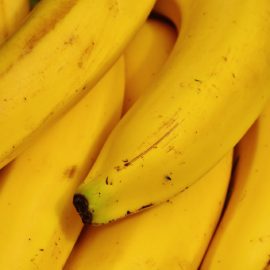
Butter is a popular dairy product because of its flavor that complements many foods. You can use butter for frying eggs, spread it on a piece of bread, make buttered corn, and many more. Over 120 distinct compounds contribute to the flavor of butter, including fatty acids in triglycerides, lactones, methyl ketones, and diacetyl.
Butter is a concentrated form of fluid milk that is made by churning pasteurized cream. Churning involves agitation that breaches the membranes of fat globules, causing the emulsion to break, fat to consolidate, and water (buttermilk) to escape. This procedure is most easily accomplished at temperatures ranging from 59°F (15°C) to 68°F (20°C). Hence, butter is often a product originating in temperate climatic regions such as Northwestern Europe, Northwestern North America, and New Zealand.
You might also like: The Chemistry of Cheese Ripening
Bread and butter, anyone?
Like milk, butter has been a part of the human diet since the ancient times. In fact, one of the earliest evidence were Sumerian tablets that described the process of butter making. These tablets were approximately from 2,500 BCE. This cuneiform tablet in the Sumerian language described butter as an offering for the moon god Suen. There are several stories that tell the origin of butter, actually.
But interestingly, butter is one of the those foods that were invented by accident, according to Elaine Khosrova. In her book “Butter: A Rich History“, she said that butter was invented by accident during the Neolithic-era Africa around 8,000 B.C. It happened during a long distance travel of a nomadic sheepherder. Looking for a drink, he reached back for the sheepskin for milk. But the unstable mode of transportation and uneven terrain had the milk shaken. And the shaking action churned the milk into butter.
Today, butter comes in many forms, depending on the method of manufacture, the composition or origin. For example, Amish butter contains 84% butterfat, whereas American butter has 80% butterfat. In Europe, butter is churned for longer and contains a bit more butterfat.
The United States and the United Kingdom favor sweet cream butter. However, most of continental Europe prefers cultured butter, which in the US, is commonly referred to as “European-style” butter.
WHAT IS CULTURED BUTTER?
Making cultured butter is similar to making regular butter. But there is an additional step—fermentation. Fermentation is the addition of bacterial cultures, such as Lactobacilli and Streptococci, to dairy products. Hence, as the name implies, cultured butter is butter that contains live bacterial culture. The bacteria produce acids as well as aroma compounds that give butter a substantially fuller flavor. The varieties of tastes that cultured butter can give depend on the bacterial culture as well as the length of fermentation.
The first step of making butter is pasteurization, or heating at a high temperature of cream. This kills any organisms that could be hazardous to human health. The cream is then stored in a ripening tank for several hours. There, it undergoes another series of heat treatments that give butter a crystalline structure when it cools, aiding in solidification.
The next step is butter churning. The fat globules in the cream are broken down during this process. As a result, the fat coagulates into butter granules. After separating the mixture, the residual butter paste is worked until smooth. Pasteurization and then churning is regular butter making.
You might also like: Starter Cultures In Yogurt
How is it made?
For cultured butter, fermentation precedes churning. To do this, the cream is placed in a vat for one day to allow the culture to develop a complex combination of flavor compounds. Lactic acid bacteria, which are often a mixture of lactic acid-producing strains of the Lactobacillus family, can be injected into cultured butter. The mixture is then chilled to roughly 41°F (5°C) and matured or fermented for 8 hours up to 18 hours, allowing approximately half of the milk fat in the globules to form solid crystals.
Aging also weakens the membranes, causing them to break easily when churned. How quickly the milk fat separates are determined by the amount and size of crystals. Furthermore, the amount and size of crystals determine the final texture of the butter. The butter mixture is churned once it slightly warmed.


